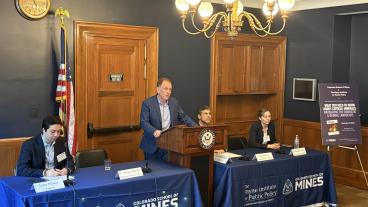Exploration geologists can devote entire careers to searching for undiscovered mineral deposits without ever chalking up a find. But for those who do, it’s tremendously rewarding, and many go on to more discoveries.
 |
| In 2001, graduate student Russell Dow was studying satellite imagery of the known Arizaro deposit in Argentina, when he noticed a corona of white on a hill nearby. Samples he took from Lindero a few months later proved his hunch was well founded. |
Seated atop a glistening, rock-strewn hillside on a remote plateau in southwest Argentina in 2000, Russell Dow MS ’04 lit a cigarette, took in the view and quietly celebrated a moment many in his line of work go their whole lives without experiencing.
At age 26, just two days into his first field trip for his master’s thesis at Colorado School of Mines, the New Zealand-born exploration geologist had found a virgin deposit that later would be estimated to contain 2 million ounces of easily accessible gold.
“I sat down and thought, ‘Wow. This is it. This might be the one shot in your career where you find something really good,’” recalls Dow. “I relished that moment.”
Such discoveries are exceedingly rare, and getting rarer, as the low-hanging fruit—rich surface deposits easily found—become depleted, requiring intrepid geologists to follow fewer clues deeper below the surface in ever more remote regions. Mines economists estimate it takes 1,000 investigations to generate 100 mineral deposit targets worth drilling. Of those, perhaps one becomes a profitable mine.



